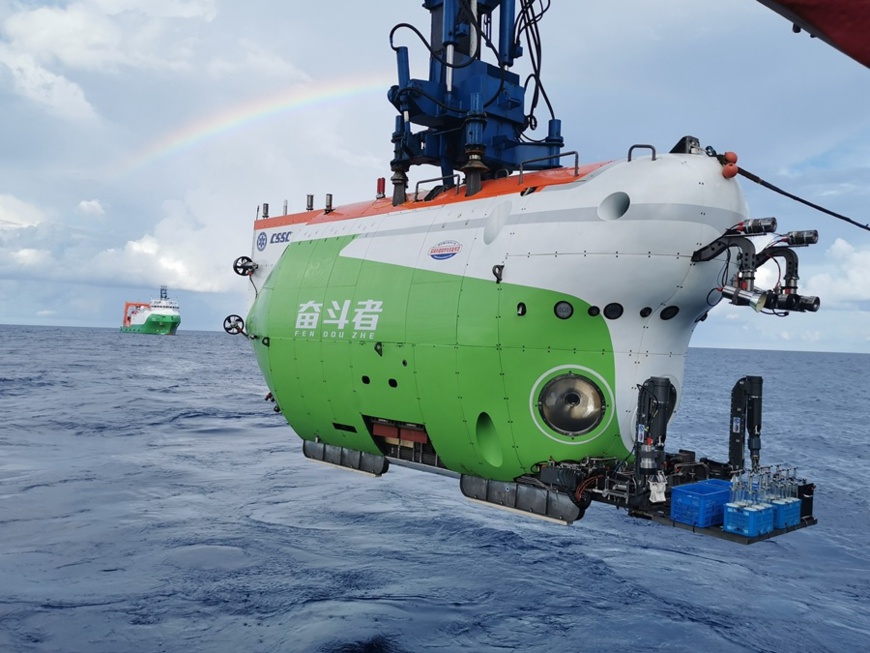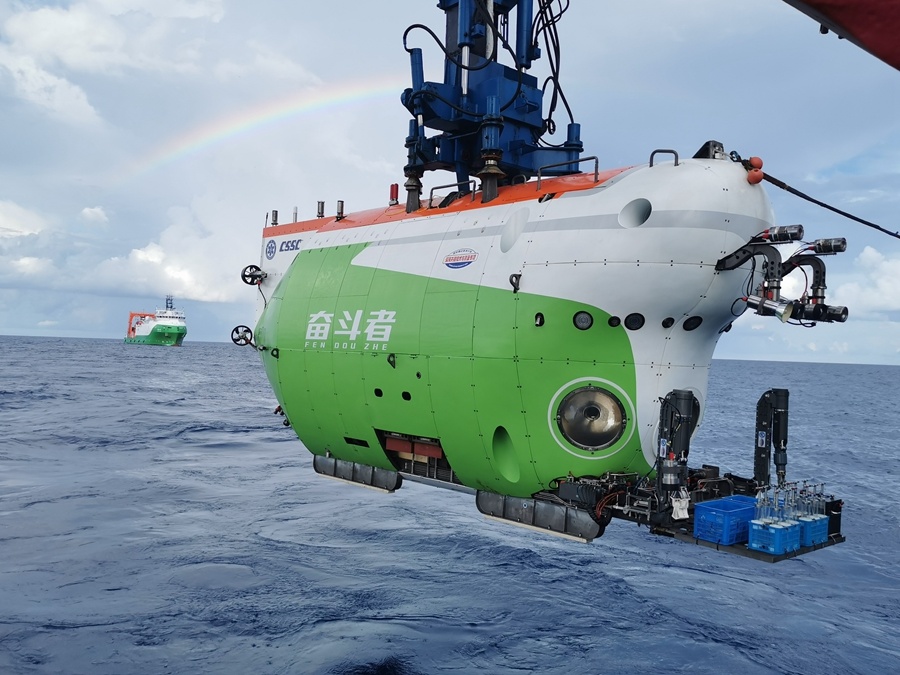By Wu Yuehui, People’s Daily

China’s deep-sea manned submersible Fendouzhe is being lowered into the water. (Photo/Chinese Academy of Sciences)
China’s deep-sea manned submersible Fendouzhe, or Striver, returned to Sanya in south China’s Hainan province on Nov. 28, after completing 10,000-meter sea trials.
On Oct. 10, the submersible departed from a dock at the Nanshan Port in Yazhou Bay of Sanya for 10,000-meter sea trials in the Mariana Trench, the world’s deepest natural trench in the western Pacific Ocean. Since then, it has delivered successful outcomes.
Fendouzhe first broke the 10,000-meter milestone on Oct. 27 and set a new national diving record of 10,909 meters on Nov. 10.
On Nov. 13, a joint operation of the manned submersible and its deep-sea lander was carried out at the 10,000-meter seabed. The operation, the first of its kind in the world, was also live-streamed.
By Nov. 19, Fendouzhe successfully completed 13 dives, eight of which exceeded a depth of 10,000 meters, in the Mariana Trench.
Fendouzhe is the world’s first manned submersible capable of carrying up to three divers for the 10,000-meter deep-sea diving operation.
The record was enabled by China’s independent research capability and a number of home-made products regarding several key technologies and important materials. Over 96.5 percent of the submersible’s core components have been independently developed by China.
Extreme water pressure is the first challenge that requires dealing with during a 10,000-meter deep-sea exploration. Cloaked in perpetual darkness and extremely low temperature, the Mariana Trench is one of the most extreme areas on Earth.
At 10,000 meters down in the trench, the submersible has to cope with about 1,100 atmospheres of pressure, which is equivalent to 2,000 elephants stepping on a person’s back. How does Fendouzhe move freely at a depth of 10,000 meters?
The key lies in its manned cabin. As a core and key component of a deep-sea manned submersible, the manned cabin is a hardware guarantee and safety barrier for humans to reach down to 10,000 meters deep in the ocean and indicates a country’s strength in manned submersible technology.
Given the extreme pressure conditions at a depth of 10,000 meters underwater and Fendouzhe’s target size and thickness requirements, the materials used in China’s previous deep-diving submersibles couldn’t meet the standard.
The Institute of Metal Research under the Chinese Academy of Sciences (CAS), together with many Chinese companies and research institutes, overcame key technical bottlenecks through investigation and research experiments, and developed new titanium alloy material Ti62A, successfully solving problems such as the strength, toughness and weldability of materials for the manned cabin.
To avoid risks of collision in the dark deep sea with complex terrain, Fendouzhe requires the precise command of its control system.
To this end, researchers with the CAS tackled a series of technical problems in a complex deep-abyss environment and enabled functions of the submersible’s control system such as online intelligent fault diagnosis based on data and model prediction, fault-tolerant control based on online control distribution, and autonomous collision avoidance in the seabed.
“The neural network optimization algorithm we designed enables Fendouzhe to realize automatic cruising according to the seabed terrain, and fixed-point navigation, hovering and positioning,” said Zhao Yang, a researcher at the Shenyang Institute of Automation under the CAS and deputy chief designer of Fendouzhe.
Zhao added that the performance indicators of its horizontal and vertical navigation control have reached the international frontier level.
Researchers also equipped the submersible with two flexible and strong “arms.” “The submersible uses two hydraulic manipulator arms we designed for its 10,000-meter deep-sea operation. Each 7-joint arm with 6 degrees-of-freedom control and a weight-carrying capability of more than 60 kilograms can cover the sampling basket and its front areas and has strong operation capabilities,” said a researcher.
With its arms, Fendouzhe collected samples of ocean rocks, marine organisms and seabed sediments by diving to a depth of 10,000 meters below the surface of the ocean. It is the first time that China has adopted hydraulic manipulator arms to carry out deep-sea tasks.
“Dear audience, the 10,000-meter seafloor is wonderful beyond words. We hope to show you sceneries under the 10,000-meter seabed through the ‘eyes’ of Fendouzhe,” said three Fendouzhe divers.
They shared their feelings through an underwater acoustic communication system immediately when the submersible successfully landed on the seabed of the Mariana Trench at 8: 12 a.m. on Nov. 10.
As the only link between Fendouzhe and its mother ship Tansuo-1, the underwater acoustic communication system is able to transmit text, voice, and images in real time from the 10,000-meter seabed to the mother ship.
Compared with its two predecessors, Jiaolong and Shenhai Yongshi, or Deep Sea Warrior, the acoustic system of Fendouzhe is completely domestically made.
What’s more, the acoustic system also contributes to the submersible’s accurate operation at the 10,000-meter seabed.
For example, its integrated navigation system, which consists of the Doppler velocity log, the positioning sonar, and the inertial navigation equipment, provides high-precision underwater positioning and navigation for the operation of Fendouzhe.
“With the help of the integrated navigation system and sonar equipment, the divers in Fendouzhe successfully retrieved three underwater samplers on Nov. 16, earlier placed on the 10,000-meter seabed, in only half an hour,” said Liu Yeyao, one of Fendouzhe’s three divers and also a senior engineer at the Institute of Acoustics under the CAS.
The sampling image was also transmitted back to the mother ship through the underwater acoustic communication modem, Liu added.
On Oct. 10, the submersible departed from a dock at the Nanshan Port in Yazhou Bay of Sanya for 10,000-meter sea trials in the Mariana Trench, the world’s deepest natural trench in the western Pacific Ocean. Since then, it has delivered successful outcomes.
Fendouzhe first broke the 10,000-meter milestone on Oct. 27 and set a new national diving record of 10,909 meters on Nov. 10.
On Nov. 13, a joint operation of the manned submersible and its deep-sea lander was carried out at the 10,000-meter seabed. The operation, the first of its kind in the world, was also live-streamed.
By Nov. 19, Fendouzhe successfully completed 13 dives, eight of which exceeded a depth of 10,000 meters, in the Mariana Trench.
Fendouzhe is the world’s first manned submersible capable of carrying up to three divers for the 10,000-meter deep-sea diving operation.
The record was enabled by China’s independent research capability and a number of home-made products regarding several key technologies and important materials. Over 96.5 percent of the submersible’s core components have been independently developed by China.
Extreme water pressure is the first challenge that requires dealing with during a 10,000-meter deep-sea exploration. Cloaked in perpetual darkness and extremely low temperature, the Mariana Trench is one of the most extreme areas on Earth.
At 10,000 meters down in the trench, the submersible has to cope with about 1,100 atmospheres of pressure, which is equivalent to 2,000 elephants stepping on a person’s back. How does Fendouzhe move freely at a depth of 10,000 meters?
The key lies in its manned cabin. As a core and key component of a deep-sea manned submersible, the manned cabin is a hardware guarantee and safety barrier for humans to reach down to 10,000 meters deep in the ocean and indicates a country’s strength in manned submersible technology.
Given the extreme pressure conditions at a depth of 10,000 meters underwater and Fendouzhe’s target size and thickness requirements, the materials used in China’s previous deep-diving submersibles couldn’t meet the standard.
The Institute of Metal Research under the Chinese Academy of Sciences (CAS), together with many Chinese companies and research institutes, overcame key technical bottlenecks through investigation and research experiments, and developed new titanium alloy material Ti62A, successfully solving problems such as the strength, toughness and weldability of materials for the manned cabin.
To avoid risks of collision in the dark deep sea with complex terrain, Fendouzhe requires the precise command of its control system.
To this end, researchers with the CAS tackled a series of technical problems in a complex deep-abyss environment and enabled functions of the submersible’s control system such as online intelligent fault diagnosis based on data and model prediction, fault-tolerant control based on online control distribution, and autonomous collision avoidance in the seabed.
“The neural network optimization algorithm we designed enables Fendouzhe to realize automatic cruising according to the seabed terrain, and fixed-point navigation, hovering and positioning,” said Zhao Yang, a researcher at the Shenyang Institute of Automation under the CAS and deputy chief designer of Fendouzhe.
Zhao added that the performance indicators of its horizontal and vertical navigation control have reached the international frontier level.
Researchers also equipped the submersible with two flexible and strong “arms.” “The submersible uses two hydraulic manipulator arms we designed for its 10,000-meter deep-sea operation. Each 7-joint arm with 6 degrees-of-freedom control and a weight-carrying capability of more than 60 kilograms can cover the sampling basket and its front areas and has strong operation capabilities,” said a researcher.
With its arms, Fendouzhe collected samples of ocean rocks, marine organisms and seabed sediments by diving to a depth of 10,000 meters below the surface of the ocean. It is the first time that China has adopted hydraulic manipulator arms to carry out deep-sea tasks.
“Dear audience, the 10,000-meter seafloor is wonderful beyond words. We hope to show you sceneries under the 10,000-meter seabed through the ‘eyes’ of Fendouzhe,” said three Fendouzhe divers.
They shared their feelings through an underwater acoustic communication system immediately when the submersible successfully landed on the seabed of the Mariana Trench at 8: 12 a.m. on Nov. 10.
As the only link between Fendouzhe and its mother ship Tansuo-1, the underwater acoustic communication system is able to transmit text, voice, and images in real time from the 10,000-meter seabed to the mother ship.
Compared with its two predecessors, Jiaolong and Shenhai Yongshi, or Deep Sea Warrior, the acoustic system of Fendouzhe is completely domestically made.
What’s more, the acoustic system also contributes to the submersible’s accurate operation at the 10,000-meter seabed.
For example, its integrated navigation system, which consists of the Doppler velocity log, the positioning sonar, and the inertial navigation equipment, provides high-precision underwater positioning and navigation for the operation of Fendouzhe.
“With the help of the integrated navigation system and sonar equipment, the divers in Fendouzhe successfully retrieved three underwater samplers on Nov. 16, earlier placed on the 10,000-meter seabed, in only half an hour,” said Liu Yeyao, one of Fendouzhe’s three divers and also a senior engineer at the Institute of Acoustics under the CAS.
The sampling image was also transmitted back to the mother ship through the underwater acoustic communication modem, Liu added.
 Menu
Menu
 China’s deep-sea manned submersible Fendouzhe completes 10,000-meter sea trials
China’s deep-sea manned submersible Fendouzhe completes 10,000-meter sea trials
















